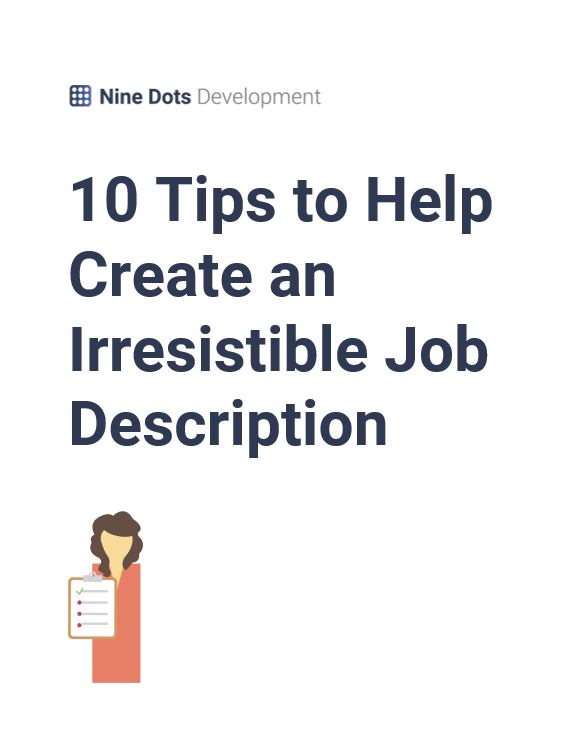Thursday 21 Oct 2021 Article
The TakeawaySetting Up The Perfect Interview
Staff Development in the New World
Part 4
#Tips #HowTo #Recruitment #Interviewing #PeopleDevelopment
The perfectly matched resource for this article...
10 Tips to Help Create an Irresistible Job Description
What starts off and ultimately sets the tone for this process is the job description - without a job description, you have no applicants, no interviews to arrange, and therefore no one to hire - so it is arguably the most important part.
Download!Playing catchup?
Setting Up The Perfect Interview
Whilst employers do choose their employees, employees do very much choose their employers too; the best talent often has the luxury of having multiple job offers, allowing them to choose who they want to work for.
Lots of employers think that this choice depends solely on salary and job description but in reality, 70% of people wouldn't accept a job somewhere with a bad reputation, or with a company they didn’t like, even if they wanted the job itself. Your interview process is what sets the scene for potential employees and determines their first impression of your organisation.
In today’s article, we explore how to set up the perfect interview process that sells your company and attracts and wins top talent; it’s the littlest things that can make the biggest difference.
Creating a Compelling Job Description
Whether you’re recruiting through an agency or placing a job advert on sites like Monster or Indeed, your job description is likely to be the first exposure that potential candidates have to your company so it’s crucial to get it right.
In her book ‘HR Disrupted’, Lucy Adams uses the fantastic framework ‘E.A.C.H’ that she says employers should keep in mind whenever they’re dealing with employees (or potential employees) in any way. The framework states that Employees must be treated as Adults, Customers, and Humans. Keeping these things in mind will help you write a compelling job description that, when paired with a fair salary, will attract the very best talent.

Contacting Applicants and Arranging Interviews
Once you have applicants, it’s time to arrange the interviews. At this stage, many employers think “well I can just send out an email based on the template we’ve used for decades and offer them each a different time on a particular day”. What’s wrong with that? Well, there are a few things to take into consideration:
Who should the interview offer come from?
- Should it come from a PA that shows you’re a bigger company?
Should it come from the Director to make the candidate feel valued and important? - How should the interview offer be communicated?
Email? A phone call? A text? A letter? What does this say about the company? - How formal does it need to be?
Is the candidate applying for a director position and may therefore expect a formal interview offer? Are they applying for a junior digital marketing role and may therefore prefer a more down-to-earth, friendly approach? - How do you arrange the interview?
Do you ask if a set date and time works for them? Do you give them multiple dates and times to choose from? Do you send them a calendar invite once the interview is arranged?
The answers to these questions will vary based on your industry, company culture, and the role you’re hiring for. For example, if we at Nine Dots were hiring for a Marketing Assistant position, our approach may look something like this:
- Once we choose who we want to interview, they each get a call from our Marketing Director to make them feel truly valued.
- The call is delivered in a professional but friendly tone, portraying us as a fun and approachable department and business.
- The candidates are given a selection of dates and times to choose from because we understand that they may have other plans in place. Once a date and time is agreed, a calendar invite is sent out.
- The director then explains what to expect on the day of the interview, makes sure they know how to get there, and gives them a personal phone number in case they have any issues on the day or any questions beforehand.
- The call concludes with our Marketing Director saying he can’t wait to meet them, and then a follow-up email is sent to confirm what has been agreed.
{{ADVERT}}
The Big Day
The morning of the interview is the prime time to get the candidate enthusiastic and motivated, so you could send them a message saying you’re excited to see and get to know them, adding that human touch that makes great companies stand out from the rest. You will likely get more from the candidate this way too.
When the interviewee arrives, it’s great to greet them by their name to make them feel valued as an individual. Common practices like offering them a drink and making sure they have somewhere to sit if they need to wait are also steps in the right direction.
During the interview, it can be tempting to start talking about the company straight away to try and sell it to the interviewee. However, it can be better to let the candidate talk first and tell you about themselves; after all, the interview is about them. In one of our previous articles, we explored common interview mistakes to avoid and how to hold a fantastic interview.
Above all, interviews should be a two-way conversation that builds a relationship between the interviewer and interviewee, in a lot of scenarios an ideal interview is not an interrogation that makes them feel uncomfortable and put on-the-spot.

Delivering the Good (or Bad) News
After the interview, before you even think about who you want to hire, you should get in contact with all of the interviewees to let them know when they can expect to hear back from you as to whether they’ve been successful or not.
Once you have made your decision about who to hire, it’s time to deliver the news. Delivering the good news to the successful candidate is of course important and should be delivered with great excitement, but following up with the people who didn’t get the job is equally important - every candidate matters. They may not have been successful this time but businesses should aim to keep a pool of potential candidates which they can draw on as they need to by keeping good relationships with them and not burning bridges. This means that when you make the dreaded phone call or send the email, you could include thoughtful touches like:
- Thanking them for their time
- Telling them what went well in the interview
- Telling them the reason you didn’t choose to hire them
- Asking item if they’re willing to keep lines on communication open in case another job opportunity appears in the future that may be better suited to them
It’s the Little Things that Matter Most
As this article explores, it’s the littlest things that can make the biggest difference; all of these things paint a picture of what your business culture is like and what it’s like to work there, determining whether you attract and win top talent or not. You want the job offer and the interview experience to be so attractive that candidates are gutted if they don’t get it.
What starts off and ultimately sets the tone for this process is the job description - without a job description, you have no applicants, no interviews to arrange, and therefore no one to hire - so it is arguably the most important part. With this, you can download our ‘10 Tips to Help Create an Irresistible Job Description’ guide here.
---
Until next time...
10 Tips to Help Create an Irresistible Job Description
What starts off and ultimately sets the tone for this process is the job description - without a job description, you have no applicants, no interviews to arrange, and therefore no one to hire - so it is arguably the most important part.
Download!Missed an article?
More from Staff Development in the New World
